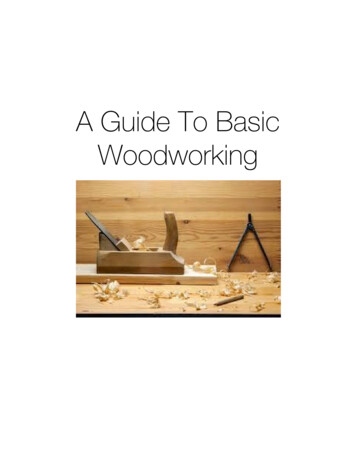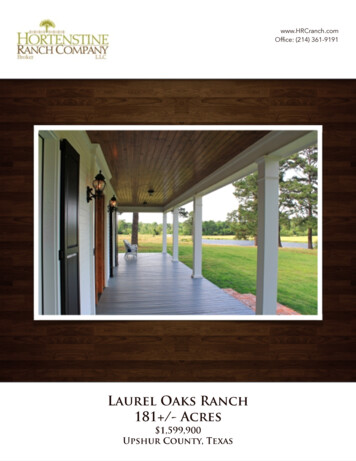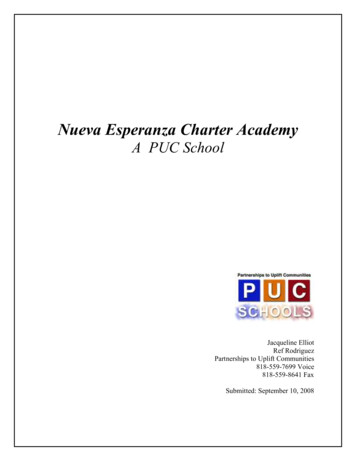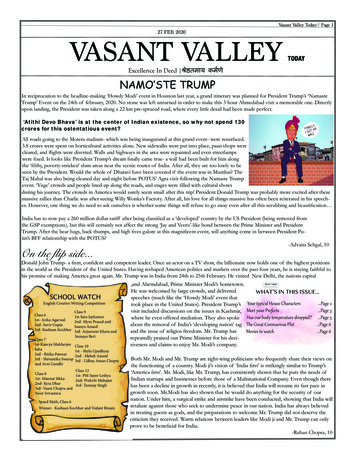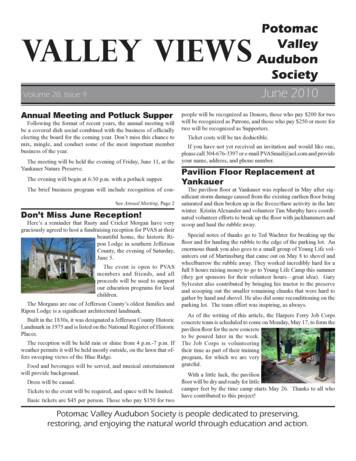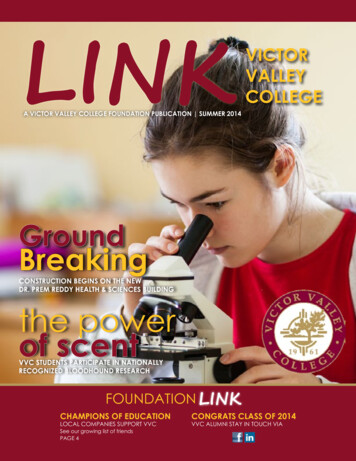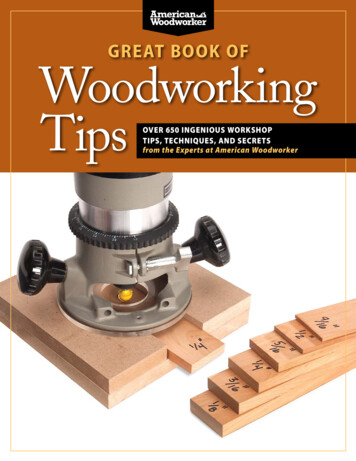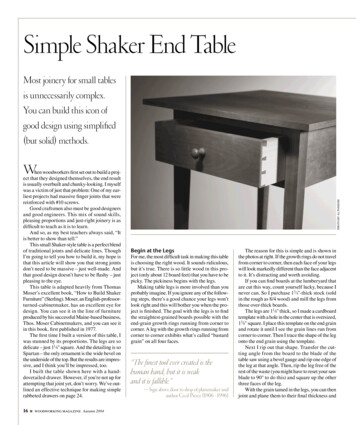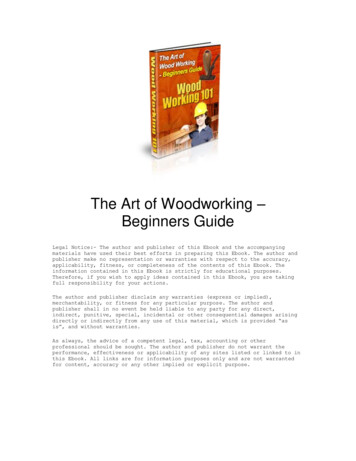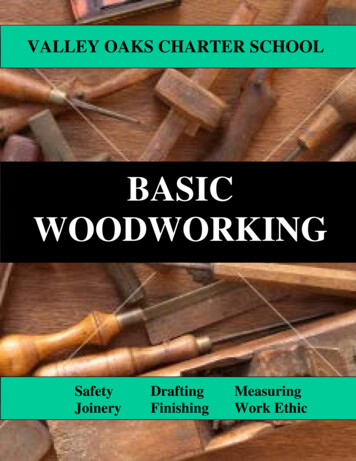
Transcription
BASICWOODWORKINGVALLEY OAKS CHARTER ngMeasuringWork Ethic1
BASICWOODWORKINGContentsWELCOME:ExpectationsOral presentationPrompt writingEvaluationsUNIT 1: SAFETYGeneral Shop Safety IPower ToolsGeneral Shop Safety I IHand ToolsWoodworking TerminologyUNIT 2: DRAFTINGIntroduction to DraftingDimensions and NotesMulti-view drawingsSectionsLine Type and QualityUNIT 3: MEASURINGHow to MeasureMeasuring TerminologyTrue SizeUNIT 4: JOINERYIntroduction to JoineryRods and SplinesSquaring WoodClamping and GluingMetal FastenersUNIT 5: FINISHINGSurface PreparationTop CoatingFriends and FoesOil and WaxWood StainingWork Ethic StandardsI-ManagementUNIT 6: WORK ETHICIntroduction to Work EthicStress Management2
BASICWOODWORKINGWelcomeEXPECTATIONSIntroductionThe Woodworking Department of Valley Oaks Charter School exists to partner with parents by helpingstudents reach their fullest potential as:Academic Achievers who have a passion for life-long learning.Effective Communicators who demonstrate competence in oral, written, illustrative, and artistic communication.Critical Thinkers who can analytically read construction plans, build woodworking projects, and prepare woodsurfaces for finishing material.Literate Operators of Technology who efficiently, effectively, and safely utilize woodworking equipment toproduce useable products.Culturally Aware Citizens who considerately and selflessly work with others.Motivated, Self-Directed People who strive to learn and apply goal setting techniques, organize and managetime efficiently, and assume personal responsibility for planning, constructing, and finishing woodworkingprojects.Teaching Method:To help each student reach his or her fullest potential, we employ the LEARN method of instruction,which is an acronym that stands for Listening, Examining, Applying, Researching, and Notifying. That isto say, students will learn by:Listening to information taught in classExamining classroom demonstrations and methods of woodworking techniquesAppling what is learned by building woodworking project(s)Researching outside articles to further gain knowledge on given subject matterNotifying others what has been learned through written responses, group collaborations, and oral presentations.3
BASICWOODWORKINGWelcomePROMPT WRITINGIntroductionEach week students are required to write a response to a prompt. Prompts are provided at the beginning ofeach unit of study and are designed to help students fully process what they have seen and heard in the classroom.To do so, students are required to investigate each topic presented in the prompt by researching outside articles onthe internet. Following are the requirements for submitting prompt responses to the instructor: At least one quote from an online article must be included in your work. Dictionary and/or encyclopediareferences will not be accepted. Make certain citations are in quotation marks and numbered. At least one quote about the subject from this class textbook must be included in your submittal. Resources must be listed at the bottom of the page under RESOURCE CITED as follows: Name of author,Name of article, Web URL address, the date you found it. For citing the text, simply put down the name ofthe text, the chapter, and the page number (see below). Prompt submission requirements are as follows:Top right hand cornerNameDateClass namePrompt numberFirst line of page, starting at the left hand margin: Prompt number followed by the prompt written andunderlined. Prompt responses shall be graded as follows: Internet citation(s) 1pt. Class textbook citation(s) 1 pt.Minimum amount of words included 1 pt. Submission requirements of prompt are met 1 pt. Workturned in is legible and well organized 1 pt. Prompt responses will not be returned to the student, but shall be submitted to his/her resource teacher. Late papers shall receive a reduction in points. Homework not turned in before the unit test shall receive a “0”.Sample:Joe SmithFebruary 2, 2014Advanced WoodworkingPrompt #18Prompt 18: In 150 words, explain how to submit prompt responses to the instructor.Skip a line and then begin writing your answer. “Whenever you refer to or use another's words, facts orideas in your paper, you are required to cite the source.”1 It’s that easy. Just explore the web by typingthe topic in a search engine, find an article, and include a quote in your response. And don’t forget,“make certain the citation is in quotation marks.”2 Of course you will say all of this in 150 words. Besure to include practical “how to” information in your response, and use your own words.RESOURCE CITED:Georgetown University Library, Turabian footnote/endnote research-guides/turabian-footnote-guide, 5/17/132Advanced Woodworking, Valley Oaks Charter School, Welcome: Prompt Writing, p. 414
BASICWOODWORKINGWelcomeEVALUATIONSIntroductionTo further help students comprehend the subject matter presented in this text and the corresponding labwork they are required to prepare for evaluations by reviewing the material, processing it, and presentingwhat they learned to the instructor. A list of evaluations and a brief description are below.Daily Evaluations:Developing a good work ethic is very important. Students will receive daily work ethic grades basedon their diligence, behavior, and cooperation in class.Unit tests:Unit tests are multiple choice questions pulled directly from the text.Group tests:The students work together to solve a problem presented to them by the instructor. After they choosethe role each will play on the problem solving team (facilitator, presenter, secretary, messenger,researcher, illustrator, and problem solver), the students pull together their combined knowledge todevelop a solution. Each member of the team receives the same grade for the presentation. Individualparticipant scores are given by the students after a peer evaluation.Project Evaluations:Student projects will be evaluated accordingly. Please see the “project evaluation form” in theappendix for further detail.25% Project Preparation/Drafting Plans25% Project Construction25% Finish (sanding, stain, topcoat, wax, etc.)25% Work Ethic5
BASICWOODWORKING6
BASICWOODWORKINGBASICWOODWORKINGUnit IGeneral Shop SafetyHand Tools and Power ToolsTool CertificationVirtues of WoodworkingWoodworking Terminology7
BASICWOODWORKINGBASICWOODWORKINGUnit PromptsAnswers to prompts must include one reference from the class text and onereference from an internet article (dictionary and encyclopedia resources willnot be accepted). Be sure to put quotation marks around your citations, numberthem, and place footnotes at the bottom of your paper to reference where yourcitation came from.Prompt 1: In 150 words, explain the number one cause of accidents in thewoodshop and why it occurs. How can you avoid it happening toyou?Prompt 2: In 150 words, look over the Ten Commandments of Machine Safetyas found in this text. Place the commandments in order of mostimportant to least important. Explain your reasoning.Prompt 3: In 150 words, explain three ways people put themselves in dangerwhile working in the woodshop and three ways they put others indanger while working in the woodshop. Also, list the purpose,warning, and major cause of accident for each of the following:miter saw, drill press, table sander, and scroll sawPrompt 4: In 150 words, explain how impatience and hurrying to finish a taskcan be your worst enemy. Explain how the virtues of patience,peace, and self-control will help you?Prompt 5: Write the definition for the following woodworking terms:Board FaceBoard EdgeBoard EndFenceGrainGritKerfWarpClampSquarePaint thinnerJoint/joineryCountersink Kick-backWith the grain/Across the grain.Rip CutCrosscut8
BASICWOODWORKINGSafetyChapter 1General Shop SafetyIntroduction:The following shop safety rules have been put in place for student safety while working in the ValleyOaks Charter School (VOCS) woodshop. Please read the entire safety manual found in the appendix of thisbook. All safety rules must be followed COMPLETELY by ALL students. Those students who do notfollow the safety rules will be dropped from the class and not allowed to re-enter.After completing the General Safety Exams with 100% accuracy, the student shall be considered ShopSafety Certified and given the privilege of working in the VOCS woodshop. He or she must at that timereceive parental permission authorizing him/her to use power machinery (see CONSENT TO USE POWERTOOLS in the appendix). Though no student will at any time be forced to use power tools, neither will heor she be permitted to use power tools unless the CONSENT TO USE POWER TOOLS form is properlysigned and on file with VOCS. Once the form has been filed, the student will receive instruction regardingwoodshop machinery. Only after a student has become tool certified on a given piece of machinery willhe/she be allowed to work on that machine. This is accomplished only after the teacher has shown thestudent the proper and safe way to use a piece of equipment and the student passes the Tool CertificationTest with 100% accuracy. Still, every time a student wishes to use a machine, he/she must get permissionfrom the instructor.“Always Think Safety”All accidents can be prevented with common sense and attention to the safety rules.A. Proper Personal Protective Equipment1.Required safety geara.2.Safety glasses: Students must wear safety glasses at all times while in the woodshoparea to prevent flying particles or corrosive substances (stain, lacquer, oils, etc) fromentering their eyes.Required safety dress code:Safety Glassesa.Nothing loose. Tie up, roll up, fasten, or remove any loose clothing, long sleeves,scarves, jewelry, and hair. Such items are easily caught in moving parts and cancause serious injury.b.Do not wear rings, watches, sweaters, loose long sleeve shirts, etc., as this willincrease chances for an accident as such items could get caught in the equipmentc.Flat no-slip shoes that cover the top of your feet and toes must be worn. Such shoesprevent slipping and help avoid toe injuries.d.Recommended personal protective equipment: It is recommended that students wearear plugs/muffs and a dust mask. It is also recommended students wear goggles and aface shield for those operations that throw a lot of wood chips.e.DO NOT WEAR GLOVES when operating rotating or reciprocating machines.Gloves hinder the ability to effectively use your hands and may get caught in movingmachinery.Face ShieldDust MaskSafetyEar Muffs9
BASICWOODWORKINGSafetyB. Proper Preparation1. Project planning:a. Plan the work and work the plan. Come to the woodshop prepared and have a clear plan of whatyou will be doing. Doing so helps you keep your mind on what you’re doing.b. Think it through. Know what operations you will be performing, the order in which you will bedoing the work, and how you are going to make the cut. Know what you are going to do, andhow you are going to do it BEFORE you begin. If you are not certain, ask for help. Rehearse cutsbefore cutting. Measure twice, cut once.c. Tool Certification: You must be certified to use a piece of machinery before using it. A writtenand oral safety test must be passed with a 100% accuracy before being certified.2. Attitude:a. Come with an attitude to work and to work safely. The number one cause of accidents is “notpaying attention.” Keep your mind on your work.b. You MUST NOT PLAY, CLOWN AROUND, or RUN in the shop area. Do not tamper or playwith tools. What I mean is no horseplay or you will be dropped from the class.c. Always keep your mind on your work and do not talk to others while operating equipment.Talking with others can result in an accident. If your mind is on someone else, it is not on yourwork.d. Be patient, kind, and courteous. Do not rush your work or the work of the person using themachine for which you are waiting. Do not crowd or hurry a person at a machine. A distractedworker is an accident waiting to happen.e. Think safe, feel safe: You are under no obligation to use power tools or machinery. If you do notfeel safe using a certain tool, do not use that tool. Similarly, if you are in any doubt about how touse a piece of machinery or the cut you plan to make, inform the instructor.f. Never talk to or distract a student using a machine. Such distractions can cause serious injury.You must stand outside the yellow lines when the area is occupied by a user.g. Never allow yourself to be distracted while using a machine. If someone talks to you, ignorethem, finish your cut, turn off the machine, wait for the blade to stop, and then address them.Never turn on a machine when someone else is inside the yellow lines with you.h. If you feel ill or are on any medication that could impair your ability to work safely, inform theinstructor. Moreover, if your mind is “elsewhere” (problems at home, relational issues, worry,stress, etc.), do not work on machinery. Rather, perform work that is not dangerous, such asdrafting, organizing, sanding, staining, or cleaning.i. Report any injury to the teacher immediately, no matter how small the injury is.j. We are here to work hard and efficiently. Do not sit on workbenches or machinery.3. Wood selection:a. Only material furnished or approved by the instructor is to be used.b. All material is to be inspected for knots and nails before using. These may fly off during cuttingand cause bodily injury or damage the machine.c. Do not use green lumber in any milling process. Green lumber is wood that has not beenthoroughly dried. It is wet on the inside and contains tree sap. This type of wood will change overtime (warp, bow, twist, etc.) as well as grow mold.10
BASICWOODWORKINGSafetyC. Proper work environment1. Cleanlinessa. It is every student’s responsibility to clean the shop at the end of class.b. Keep the floor clea
02.02.2014 · Advanced Woodworking, Valley Oaks Charter School, Welcome: Prompt Writing, p. 4 . 5 . BASIC WOODWORKING . EVALUATIONS . Introduction . To further help students comprehend the subject matter presented in this text and the corresponding lab work they are required to prepare for evaluations by reviewing the material, processing it, and presenting what they learned to the
